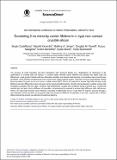| dc.contributor.author | Kivambe, Maulid | |
| dc.contributor.author | Powell, Douglas M. | |
| dc.contributor.author | Nakajima, Kazuo | |
| dc.contributor.author | Morishita, Kohei | |
| dc.contributor.author | Murai, Ryota | |
| dc.contributor.author | Castellanos, Sergio | |
| dc.contributor.author | Jensen, Mallory Ann | |
| dc.contributor.author | Buonassisi, Anthony | |
| dc.date.accessioned | 2018-11-07T18:57:37Z | |
| dc.date.available | 2018-11-07T18:57:37Z | |
| dc.date.issued | 2016-09 | |
| dc.identifier.issn | 1876-6102 | |
| dc.identifier.uri | http://hdl.handle.net/1721.1/118945 | |
| dc.description.abstract | The presence of metal impurities and their interactions with structural defects (e.g., dislocations) are deleterious to the performance of Si-based solar cell devices. To achieve higher minority carrier lifetimes that translate into higher solar cell efficiencies, novel growth methods with low dislocation densities and reduced metal impurity concentrations have recently been developed. These methods simultaneously aim to achieve low capital expense (capex), necessary to ensure rapid industry scaling. Monocrystalline Si grown by the non-contact crucible method (NOC-Si) has the potential to achieve high bulk minority carrier lifetimes and high efficiencies at low cost given its low structural defect density. Growth in large-diameter crucibles ensures high throughput consistent with low capex. However, high temperatures, coupled with conditions during Si growth (e.g., crucible and ambient gas) can lead to the in-diffusion of impurities, compromising the potential to achieve high efficiency solar cell devices. Herein, we report high minority-carrier lifetimes exceeding 3 milliseconds (ms) in n-type NOC-Si material, achieved through a strict impurity-control procedure at the growth stage that prevents in-diffusion of impurities to the melt, coupled with a tailored defect-engineering process via optimized phosphorus gettering. Keywords: defects; impurities; minority-carrier lifetime; non-contact crucible; top-seeded solution growth; silicon; solar cells | en_US |
| dc.description.sponsorship | National Science Foundation (U.S.) (Grant 1122374) | en_US |
| dc.description.sponsorship | National Science Foundation (U.S.) (Contract EEC-1041895) | en_US |
| dc.description.sponsorship | United States. Department of Energy (Contract EEC-1041895) | en_US |
| dc.publisher | Elsevier | en_US |
| dc.relation.isversionof | http://dx.doi.org/10.1016/J.EGYPRO.2016.07.068 | en_US |
| dc.rights | Creative Commons Attribution-NonCommercial-NoDerivs License | en_US |
| dc.rights.uri | http://creativecommons.org/licenses/by-nc-nd/4.0/ | en_US |
| dc.source | Elsevier | en_US |
| dc.title | Exceeding 3 ms Minority Carrier Lifetime in n–type Non-contact Crucible Silicon | en_US |
| dc.type | Article | en_US |
| dc.identifier.citation | Castellanos, Sergio et al.“Exceeding 3 Ms Minority Carrier Lifetime in N–type Non-Contact Crucible Silicon.” Energy Procedia 92 (August 2016): 779–784 © 2016 The Author(s) | en_US |
| dc.contributor.department | Massachusetts Institute of Technology. Department of Mechanical Engineering | en_US |
| dc.contributor.mitauthor | Castellanos, Sergio | |
| dc.contributor.mitauthor | Jensen, Mallory Ann | |
| dc.contributor.mitauthor | Buonassisi, Anthony | |
| dc.relation.journal | Energy Procedia | en_US |
| dc.eprint.version | Final published version | en_US |
| dc.type.uri | http://purl.org/eprint/type/JournalArticle | en_US |
| eprint.status | http://purl.org/eprint/status/PeerReviewed | en_US |
| dc.date.updated | 2018-11-01T13:55:54Z | |
| dspace.orderedauthors | Castellanos, Sergio; Kivambe, Maulid; Jensen, Mallory A.; Powell, Douglas M.; Nakajima, Kazuo; Morishita, Kohei; Murai, Ryota; Buonassisi, Tonio | en_US |
| dspace.embargo.terms | N | en_US |
| dc.identifier.orcid | https://orcid.org/0000-0003-3935-6701 | |
| dc.identifier.orcid | https://orcid.org/0000-0002-5353-0780 | |
| dc.identifier.orcid | https://orcid.org/0000-0001-8345-4937 | |
| mit.license | PUBLISHER_CC | en_US |
